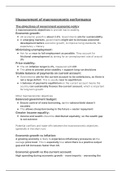Summary
Summary Measurement of macroeconomic performance
These notes provided a detailed insight into the topic of Measurement of macroeconomic performance. This is perfect for an AQA Economics A Level student. This file breaks down the content in order for it to be fully absorbed. It finds the perfect balance between bullet points, images, graphs and in...
[Show more]




